Vertical climbing is an essential behavior for arboreal animals, yet limb mechanics during climbing are poorly understood and rarely compared to those observed during horizontal walking. Primates commonly engage in both arboreal walking and vertical climbing, and this makes them an ideal taxa in which to compare these locomotor forms. Additionally, primates exhibit unusual limb mechanics compared to most other quadrupeds, with weight distribution biased towards the hindlimbs, a pattern that is argued to have evolved in response to the challenges of arboreal walking. Here we test an alternative hypothesis that functional differentiation between the limbs evolved initially as a response to climbing. Eight primate species were recorded locomoting on instrumented vertical and horizontal simulated arboreal runways. Forces along the axis of, and normal to, the support were recorded. During walking, all primates displayed forelimbs that were net braking, and hindlimbs that were net propulsive. In contrast, both limbs served a propulsive role during climbing. In all species, except the lorisids, the hindlimb produced greater propulsive forces than the forelimb during climbing. During climbing, the hindlimb tends to support compressive loads, while the forelimb forces tend to be primarily tensile. This functional disparity appears to be body-size dependent. The tensile loading of the forelimb versus the compressive loading of the hindlimb observed during climbing may have important evolutionary implications for primates, and it may be the case that hindlimb-biased weight support exhibited during quadrupedal walking in primates may be derived from their basal condition of climbing thin branches.
The evolution of vertical climbing in primates: evidence from reaction forces
Currently Viewing Accepted Manuscript - Newer Version Available
Jandy B. Hanna, Michael C. Granatosky, Pooja Rana, Daniel Schmitt; The evolution of vertical climbing in primates: evidence from reaction forces. J Exp Biol 2017; jeb.157628. doi: https://doi.org/10.1242/jeb.157628
Download citation file:
Advertisement
2023 JEB Outstanding Paper Prize shortlist and winner

The JEB Editors are delighted to announce the shortlisted authors for the 2023 JEB Outstanding Paper Prize. Read the winning paper - Tiny spies: mosquito antennae are sensitive sensors for eavesdropping on frog calls - by Hoover Pantoja-Sanchez and Brian Leavell from Ximena Bernal's lab at Purdue University, USA.
JEB Science Communication Workshop for ECRs

If you’re an early-career researcher interested in science communication and are attending the SEB Annual Conference in Prague this summer, come a day early and join the JEB Editors at a sci comm workshop to learn the key writing skills needed to promote your research to a broad audience beyond your peers (1 July at 14.30-17.30). Places are limited to 24 attendees, and applicants should apply through the SEB registration page by 30 April 2024.
Bridging the gap between controlled conditions and natural habitats in understanding behaviour

Novel technologies enable behavioural experiments with non-model species, in naturalistic habitats and with underexplored behaviours. In their Commentary, Scholz and colleagues discuss how to obtain a deeper understanding of the natural ecology and lifestyle of study animals.
Beluga metabolic measures could help save species

To help save animals from extinction, it’s important to understand what each species needs to survive. This led Jason John et al. to measure the metabolic rates of captive belugas to develop a ‘fish calculator’ showing that the whales need to eat ~23 salmon per day.
ECR Workshop on Positive Peer Review

Are you an ECR looking for tips on how to write concise, astute and useful manuscript reviews? If so, join the JEB Editors at a 2-hour JEB-sponsored Workshop on Positive Peer Review at the Canadian Society of Zoologists annual meeting in Moncton on 9 May 2024 at 13.00-15.00. There are 25 spaces for ECRs and selection is first come, first serve. To sign up, check the ECR Workshop box when you register for the CSZ meeting.



